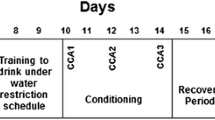Abstract
Rats were used in two experiments to investigate the influence of social variables on the acquisition of Conditioned Taste Aversion (CTA) to either lithium chloride (10 ml/kg IP of a 0.3-M solution given twice) or chlorpromazine (8 mg/kg IP given four times) and on subsequent extinction. CTA acquisition was not affected by original housing assignment (isolation or paired housing for 15–23 days prior to conditioning), by the shifted social assignment during conditioning, or by the drugged state of the paired animals' partners on drug-scheduled days. However, for both drugs, permanently isolated animals extinguished CTA more slowly than rats housed permanently in pairs. Shifts from isolation to pairing or vice versa failed to alter CTA extinction in the case of lithium, but affected it significantly in chlorpromazine-treated rats. Shifts from isolation to paired housing with an undrugged partner produced faster extinction for lithium than the corresponding group with a drugged partner. For chlorpromazine, the effect of the same shift was exactly the opposite. Overall, the results show that changes in CTA extinction can be a function of social variables.
Similar content being viewed by others
References
Archer T, Sjödén P, Nilsson L, Carter N (1979) Role of exteroceptive background context in taste-aversion conditioning and extinction. Anim Learn Behav 7:17–22
Berger BD (1972) Conditioning of food aversion by injections of psychoactive drugs. J Comp Physiol Psychol 81:21–26
Berger BD, Cwengel P, Peshkin N, Schuster R (1979) Social factors in taste aversion. Neuropharmacology 18:1003–1006
Cappell H, Le Blanc AE, Endrenyi L (1972) Effects of chlordiazepoxide and ethanol on the extinction of a conditioned taste aversion. Physiol Behav 9:167–169
Chambers KC, Sengstake CB (1978) Pseudocastration effects of social isolation on extinction of a taste aversion. Physiol Behav 21:29–32
Coombes S, Revusky S, Lett BT (1980) Long-delay taste aversion learning in an unpoisoned rat: Exposure to a poisoned rat as the unconditioned stimulus. Learn Motiv 11:256–266
D'Mello GD, Stolerman IP, Booth DA, Pilcher CWT (1977) Factors influencing flavour aversions conditioned with amphetamine in rats. Pharmacol Biochem Behav 7:815–190
Giardini V (1985) Conditioned taste aversion to chlorpromazine, but not to haloperidol. Psychopharmacology 86:81–83
Gleeson RM, Atrens DM (1982) Chlorpromazine hyperalgesia antagonizes clonidine analgesia, but enhances morphine analgesia in rats tested in a hot-water tail-flick paradigm. Psychopharmacology 78:141–146
Hoffmeister F (1975) Negative reinforcing properties of some psychotropic drugs in drug-naive rhesus monkeys. J Pharmacol Exp Ther 192:468–477
Hoffmeister F (1977) Reinforcing properties of perphenazine, haloperidol and amitryptiline in rhesus monkeys. J Pharmacol Exp Ther 200:516–522
Konorski J (1972) Some hypotheses concerning the functional organization of prefrontal cortex. Acta Neurobiol Exp 32:595–613
Mackintosh JH, Chance MRA, Silverman AP (1977) The contribution of ethological techniques to the study of drug effects. In: Iversen LL, Iversen SD, Snyder SH (eds) Handbook of psychopharmacology: vol 7. Principles of behavioral pharmacology. Plenum Press, New York
Pilcher CWT, Jones SM (1981) Social crowding enhances aversiveness of naloxone in rats. Pharmacol Biochem Behav 14:299–303
Van Putten T (1974) Why do schizophrenic patients refuse to take their drugs? Arch Gen Psychiatry 31:67–72
Van Putten T, May PRA, Jenden DJ, Cho AK, Yale C (1980) Plasma and saliva levels of chlorpromazine and subjective response. Am J Psychiatry 137:1241–1242
Van Putten T, May PRA, Marder SR (1984) Response to antipsychotic medication: The doctor's and the consumer's view. Am J Psychiatry 141:16–19
Author information
Authors and Affiliations
Rights and permissions
About this article
Cite this article
Giardini, V. Influence of housing conditions and state of partner on conditioning and extinction of taste aversion to lithium and chlorpromazine. Psychopharmacology 86, 96–101 (1985). https://doi.org/10.1007/BF00431691
Received:
Accepted:
Issue Date:
DOI: https://doi.org/10.1007/BF00431691




